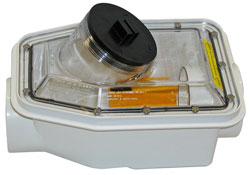Residential Flood Protection
Flooding can be caused by heavy rain, rapidly melting snow in the Spring, or a sewer blockage.
Protecting your Home from Flooding
To flood protect your home you should understand Fort St. John's two types of sewer systems as well as some key plumbing features.
The sanitary sewer carries wastewater (sewage) from your home's plumbing fixtures (toilets, sinks, laundry) to the City's wastewater treatment facilities.
The storm sewer carries water from the street and lane to drainage discharge courses, and ultimately to the Peace River and Beatton River.
Weeping tile is the perforated pipe that is buried around the foundation of your home. This pipe collects the water that pools around your home's footings and channels it to the City's sewers instead of into your basement. Older homes (built before the 1960s) may not have weeping tile. Depending on when your home was built, your weeping tile was connected to either the sanitary sewer or a sump pump, which pumps the water out onto your lawn.
The backwater valve is a component of your plumbing system that prevents water from backing up your sanitary sewer service when the City's sewers are overloaded. The cleanout allows you to access your sanitary service connection for maintenance and inspection through a screw on cover.
The key to flood protecting your home is a properly graded lot and a well maintained backwater valve. Annual maintenance is absolutely essential to flood protect your home. Make sure that all downspouts are directed away from your home’s foundation.
Annual Maintenance of Your Backwater Valve
During heavy rainfall, the storm sewer, and sometimes the sanitary sewer, may become overloaded and can force water back into your property's service line. If your backwater valve is not secure or the cover is missing or broken, this water can be forced from the pipe and into your basement.
Your backwater valve is located near a perimeter wall in an access chamber below the basement floor, most often in your utility room. They might be hidden under carpet or behind boxes of stored goods.
Depending on the age of your home, you may only have sanitary service or both sanitary and weeping tile. There should be a backwater valve on each.
Inspect your backwater valve(s) to make sure it is functioning as intended. When you remove the cover, a flapper valve should be visible. If it has fallen free from the valve body, reset the hinge as designed. If it is missing, have it replaced. Ensure that the flapper valve and threads are free of debris, sand, and sediment. A pail of warm water (no soap) should be enough to wash the sediment from the valve body. When the flapper valve is clean and positioned correctly, tighten all covers including the cleanout so that they are secure and water tight.

